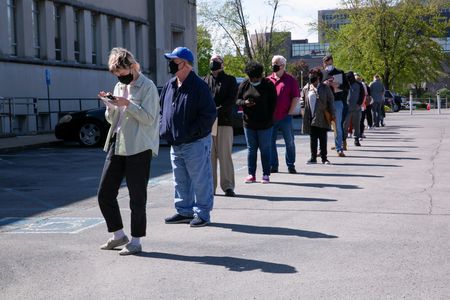By Lucia Mutikani
WASHINGTON (Reuters) – U.S. job openings unexpectedly rose in December, showing demand for labor remains strong despite higher interest rates and mounting fears of a recession, which could keep the Federal Reserve on its policy tightening path.
There were 1.9 job openings for every unemployed person in December, the Labor Department’s monthly Job Openings and Labor Turnover Survey, or JOLTS report, showed on Wednesday.
Signs of persistent labor tightness did not discourage the U.S. central bank from raising its policy rate by 25 basis points at the end of a two-day meeting on Wednesday, further slowing the pace of the Fed’s rate hikes. The Fed promised “ongoing increases” in borrowing costs.
“This could well be the first recession in history without material job losses,” said Christopher Rupkey, chief economistat FWDBONDS in New York. “It’s a good thing for the Fed that inflation pressures are cooling because the labor market isn’t cooling at all.”
Job openings, a measure of labor demand, increased by 572,000 to a five-month high of 11.0 million on the last day of December. Economists polled by Reuters had forecast 10.250 million job openings.
With vacancies concentrated in the leisure and hospitality industry as well as retail trade, some economists believed December’s surge was temporary. Others speculated that job openings had been overstated because of difficulties adjusting the data for seasonal fluctuations.
“The leisure and hospitality sector accounted for three-quarters of the total increase, rising to its highest level since December of 2021 – a month which was followed by a sharp decline in January 2022 – a pattern we expect to emerge in next month’s report,” said Matthew Martin, a U.S. economist at Oxford Economics in New York.
“A jump in job openings in the retail sector is also at odds with a lower pace of seasonal hiring around the holidays.”
There were an additional 409,000 unfilled jobs in the accommodation and food services industry. Employment in the industry remains below its pre-pandemic level. Retail trade reported 134,000 more vacancies. Construction, which has been hammered by higher borrowing costs, had 82,000 more openings.
The job openings rate up shot to 6.7% from 6.4% in November. Hiring increased to 6.2 million from 6.0 million in the prior month. The hires rate rose to 4.0% from 3.9% in November. With hiring lagging, wage growth could remain elevated, though it cooled in the fourth quarter.
Stocks on Wall Street were trading lower. The dollar slipped against a basket of currencies. U.S. Treasury prices rose.
Graphic-JOLTS: U.S. labor market churn – https://www.reuters.com/graphics/USA-STOCKS/znvnbkzlnvl/jolts.png
MANUFACTURING SLUMPS
The Fed has since last March raised its policy rate by 450 basis points from near-zero to a 4.50% and 4.75% range. The fastest monetary policy tightening cycle since the 1980s has left economists expecting a recession by the second half of the year. The housing market is depressed and the downturn in manufacturing is intensifying.
A separate report from the Institute for Supply Management (ISM) on Wednesday showed its manufacturing PMI dropped to 47.4 in January from 48.4 in December. The third straight monthly contraction pushed the index to the lowest level since May 2020 and below the 48.7 mark viewed as consistent with a recession in the broader economy.
Only one of the six largest manufacturing industries, transportation equipment, reported growth. Comments from manufacturers were mixed, with some describing business as “still strong,” while others said “sales have dropped.”
Graphic-ISM Manufacturing PMI: a breakdown – https://www.reuters.com/graphics/USA-STOCKS/zdpxdnrqapx/ism.png
Despite the deterioration in conditions, factories did not appear to be laying off workers in large numbers. According to the ISM, companies “are indicating that they are not going to substantially reduce head counts as they are positive about the second half of the year.”
That was reinforced by the JOLTS report, which showed layoffs climbing to 1.5 million in December from 1.4 million in November. The layoffs rate edged up to 1.0% from 0.9% in prior month. Workers also continued to voluntarily quit their jobs in December. The quits rates, which is viewed as a measure of labor market confidence, was unchanged at 2.7%.
A third report showed private employment increased by 106,000 jobs last month after rising by 253,000 in December, well below economists’ expectations for a gain of 178,000. The ADP National Employment report, however, attributed the weaker-than-expected private payrolls gain to bad weather in mid-January, including flooding in California.
Leisure/hospitality employment increased by 95,000 jobs last month, which economists said was at odds with bad weather holding back hiring.
The ADP report, jointly developed with the Stanford Digital Economy Lab, was published ahead of the release on Friday of the Labor Department’s more comprehensive and closely watched employment report for January.
ADP has been an unreliable predictor of private payrolls in the Labor Department employment report. According to a Reuters survey of economists, nonfarm payrolls likely increased by 185,000 jobs in January after rising by 223,000 in December.
Economists at Goldman Sachs said they did not expect a significant drag from winter weather or the California flooding in January’s employment report.
“We caution against extrapolating,” said Rubeela Farooqi, chief U.S. economist at High Frequency Economics in White Plains, New York. “Overall, the BLS data show the economy continues to create jobs at a strong pace, and the labor market is showing only gradual signs of softening despite a rapid increase in interest rates.”
(Reporting by Lucia Mutikani; Editing by Chizu Nomiyama, Paul Simao and Nick Zieminski)

